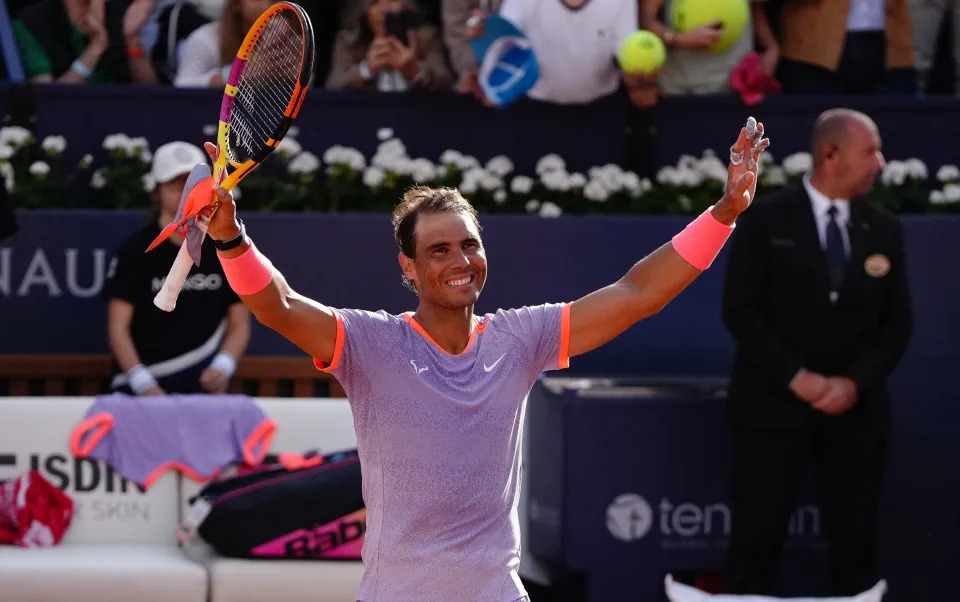After missing 102 days of action, Rafael Nadal made a simple comeback at the Barcelona Open, but concerns about his physical condition still exist.
The 22-time major champion Rafael Nadal hadn’t participated in a competitive tennis match since the Brisbane Open in January before this Tuesday. Since then, he has struggled with hip and abdominal issues, which has shortened what was supposed to be his final season.
The 37-year-old Rafael Nadal was determined to play on clay in Barcelona, where he has won 12 times and where the main court is named after him, even after withdrawing from last week’s Monte Carlo tournament.
Not only did he win 6-2 6-3 to ease his way back into competitive tennis on Tuesday, but Flavio Cobolli, his 21-year-old Italian opponent, looked vulnerable in his presence.
However, this was by no means a perfect performance because Nadal might have had trouble with his weaker serve against a more formidable opponent. Because of the abdominal ailment, Nadal has not been able to serve for the past two months, and he freely acknowledged that he was holding back against Cobolli.
His first serve average was 102 mph, which is significantly slower than his own 113 mph average at the beginning of the year and considerably below the 117 mph tour average. When he plays Australia’s Alex de Minaur on Wednesday, who is presently ranked sixth in the ATP rankings, that shot might not go as well as planned.
The one thing Rafael Nadal said he improved on made him win.
In an on-court interview, Rafael Nadal stated, “I’ve gone months without being able to serve, and although I’ve got a lot of excitement to play here and do the best I can, I’m not going to go crazy with the serve.” “I have to serve with prudence, as the circumstances demand.”
“For me, the most important thing is to have the opportunity to improve,” he later remarked. It probably won’t be wise for me to take actions today that allow me to perform better today but prevent me from playing in Madrid or Rome the following day or two. To continue learning my limits and how hard I can push myself on everything, not just the service, will require daily work.”
On Tuesday, Rafael Nadal declared that he was in “no discomfort,” but he advised everyone to proceed with prudence. This was in response to news that Stefanos Tsitsipas, who had just arrived in Barcelona from defending his title in Monte Carlo, had informed the media that he thought the Spaniard was the favorite. Nadal stated brusquely, “That’s a dumb answer.” “Everyone knows I’m not the favorite, even if I know he says so in reference to my performance in this tournament.”
Nadal’s primary goal is to avoid injury this week. It hasn’t always been easy for him to strike a balance between that and his ferocious competitive spirit, though. It was his first clay-court match in almost seven hundred days. In 2022, he won his 14th trophy at Roland Garros, but after stretching the limits of his persistent foot injury, he had to leave Paris on crutches. The next two years have been extremely difficult because extended periods of rehabilitation have been compensated with minimal court time.
On Tuesday, before a ball was even played, Rafael Nadal’s devoted Barcelona supporters showered him with praise for his comeback. Even though he wasn’t flawless and missed a few ridiculous forehands, he more than satisfied the enthusiastic audience with his signature fist pump and “Vamos!” after pinging a winning forehand down the line.
He can only hope his body holds up for this last gasp, especially on the clay, as retirement is now in his sights. To accomplish so, though, he will have to overcome his inclinations.
It’s really tough for me to make rational decisions while I’m competing, especially in venues that hold a lot of emotional significance. Because I was essentially in control today, I was able to handle. Let me see if I can continue to oversee them tomorrow.





